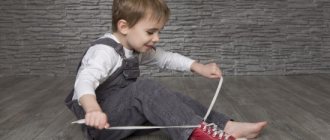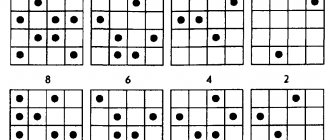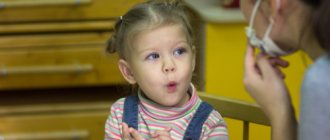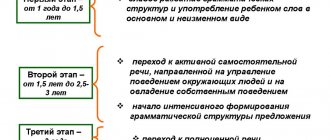Fine motor skills are a set of coordinated actions aimed at accurately performing small movements with the fingers and hands and feet. The nervous, muscular, skeletal and even visual systems take part in this. It includes a variety of movements: from familiar gestures to the smallest manipulations.
From an anatomical point of view, 1/3 of the motor projection on the cerebral cortex is precisely the projection of the hand, located next to the speech zone. This is why the development of fine motor skills in children 3-4-5 years old is so important: the development of speech skills, success in school, and the successful socialization of the child will depend on it. What are its age-related characteristics and how to achieve its maximum progress in preschool children?
Conducting classes on the development of fine motor skills in preschool educational institutions for children 3, 4 and 5 years old
The motor skills of the upper limbs directly interact with the higher functions of the psyche and consciousness: thinking, coordination, attention, observation, speech, imagination, visual memory. Its important role is that the baby’s whole life will require the further use of coordinated, precise movements of the fingers and hands. They are needed for writing, dressing, drawing, and performing other key functions and actions in the process of study, work, and life in general.
Lesson in kindergarten
Important! You can develop motor skills in children in the fourth year of life in the form of classes in kindergarten or together with their parents at home (self-education).
Goals and objectives
The goals and objectives of the development of children's motor skills in children three, four, five years old are as follows:
- stimulate the development of activity and children's speech;
- develop hand and finger movements, coordination;
- teach and train the child in the differences between colors and their comparison;
- develop fine motor skills of the main three fingers: index, thumb, middle;
- prepare the child's hand for writing;
- develop sensorimotor coordination of the upper limbs;
- indirectly affect the overall development of the baby’s intelligence;
- develop lacing skills (lacing, “bow”);
- develop orientation in space (top, bottom, left, right);
- develop perception, attention, creativity;
- develop creativity abilities.
The main types of development of fine motor skills in a child
The grouping of activities, games, and developmental exercises are divided into several types:
- finger games;
- modeling;
- games with small objects;
- drawing;
- finger massage;
- various activities associated with manual work (screwing caps, sorting beads, tearing sheets of paper, assembling mosaics, cutting).
First lessons with objects
Having learned the basic games with fingers, you can move on to the next step - practicing with objects. For the little ones, such developmental exercises will be useful.
- Working with a pencil and small hair ties. The parent holds a pencil in his hand. The child’s task is to put several small rubber bands on him one after another.
- Drawing with semolina. The parent pours a thin layer of cereal onto a flat plate or cutting board, inviting the baby to run his finger over it. You will get a line. In the same way, the child draws several stripes on the semolina.
- Laying out the beans. The mother gives the baby a small handful of beans (beads or buttons can replace them). The preschooler is required to lay it out on the table in piles or make a path.
- Working with beads, stringing large elements. They can be replaced with pasta pre-dyed in different colors.
- Working with buttons. The parent draws a circle on a piece of paper. The child is given instructions to arrange buttons, paper clips, and beans along its contour.
- Children love to imitate adults, and this should be used in organizing classes. So, the mother can invite the baby to stir the sugar in his tea himself.
- "Firework". The baby’s task is to tear a sheet of paper into as small pieces as possible and fold them on the table. Then these scraps are held in the hands and tossed, like a real fireworks display.
The main rule is to practice every day, but do not force the baby. Training should bring joy, not irritation.
Games for the development of fine motor skills in the second junior group
Games that promote the development of a child's motor skills include the following types of entertainment activities:
- fingered. They are considered a unique way to develop children's speech. Along with the exercises, kids memorize texts, which helps develop attention, memory, imagination, thinking, reaction speed, expressiveness of emotions, etc.;
- origami. Creating paper crafts without using glue is the next option for developing motor skills, which can be interesting for both children and adults;
- lacing is a type of game that is not only useful for general development, but will also help the child in the future;
- games with cereals, sand, beads, bulk substances (stringing, transferring into containers, etc.);
- modeling from clay, dough, plasticine.
How to teach a child attentiveness and perseverance at 7 years old
Games for children 1 to 3 years old
The period from 1 year to 3 years is the most greedily cognizable.
The child quickly masters the world and tries literally everything. Play and play again is the only form for communication and development of children in preschool age. Your adult nerdiness: “do this, behave correctly, etc.” will lead to nothing. Everything through the game!!! The only obstacle to this can be your laziness. Don't be lazy, play, and you will see the wonders of your gaming education.
Finger games have not been canceled
Our hit parade is still headed by finger games. These are universal games that can be played throughout the preschool or even primary school period of a child’s life (they just become a little more complicated).
| One, two, three, four, five - We went out to the kindergarten for a walk. We walk, we walk through the meadow, There flowers grow in a circle. There are exactly five petals, you can take them and count them | Using the finger of one hand, we count the fingers on the other, lightly pressing on the pads. With the index finger of one hand we perform circular strokes on the palm of the other. We count our fingers, stroking them in reverse order. |
Then we read the poem again and repeat all the movements on the other hand.
| Once you've played, relax, shake your fingers. Bend your fingers, just like bunny ears. | Relax your hands and shake them. We place both palms with fingers pressed against each other to the head and bend the closed fingers several times. |
The poem and all movements can be repeated.
Artist and sculptor
Drawing is in second place (this again, in my opinion and experience, yours may be different. Write, then we’ll discuss).
First try with your palms and fingers. Old wallpaper (there is room to roam) and paints for hand painting are perfect. This is where the fun and freedom are (the main thing is not to decorate the carpet).
Then we learn to hold a brush and pencil with crayons and draw, draw, draw!!! Moreover, at the beginning of your artist’s career, it doesn’t matter what, the main thing is that your fingers and brushes work. Your task is to inspire the master.
Modeling is definitely a favorite activity of almost all children.
Materials can be varied: plasticine, special clay,
Dough (yes, yes). Knead your child's regular unleavened dough and let him sculpt.
Make your own dumplings, sit your child next to him and let him sculpt masterpieces, it doesn’t matter that the whole kitchen and the creator are in flour, it’s all fixable, but what a pleasure it is.
We create what we want
Next on the list of popular games are all sorts of inserts and large mosaics. You can collect large buttons at home by making a slot in the lid of a plastic container that can be easily opened according to the size of the buttons. The child puts the buttons in a “piggy bank”, then pours them out, and then puts them back again. My students were simply shaking for this “piggy bank.” Attention! Take large buttons, because for some reason the temptation for children to put a button in their nose or ear is very great.
You can simply mix beans and rice and ask them to put them separately in different containers, or you can even entice your baby with role-playing games. For example, take different figures of domestic animals, make plates for them from plasticine and feed them each with cereal.
And also locks, latches, at home you can equip a mini-stand with a switch, loops with a lock, etc.
And of course, where without clothespins
This handy material is loved not only by the children themselves, but also by parents and teachers.
Firstly, everyone has clothespins at home, secondly, they cost pennies, and thirdly, they can captivate a child for a long time and with benefit.
Using clothespins you can practice construction skills and learn colors. To do this, you need to make blanks from cardboard, for example, cut out a yellow circle, which will later become a sun with rays-clothespins, or the body of a hedgehog, which will have pins-pins attached, etc.
In addition, you can cut out 4 geometric shapes of different colors from cardboard, and ask the child to put clothespins of the same color on each of them.
Exercises for the development of motor skills in the middle group of kindergarten
The list of exercises that promote the development of motor skills includes the following activities:
- drawing with pencils. Their use helps to strain the baby’s hands in order to select the pressure needed to draw lines of different thicknesses and brightness;
- collecting puzzles, mosaics, construction sets;
- fastening and unfastening buttons and locks.
Collecting paper puzzles
Card file of exercises and games with goals according to the Federal State Educational Standard
The card file of exercises according to federal standards includes the following types of classes:
- to relax your arms (hands);
- for the development of motor skills using an unsharpened hex pencil;
- for the development of motor skills using natural materials (cones);
- for the development of motor skills with the help of a prickly massage ball.
The first type includes the following exercises:
- "Fish" in the water;
- “Helicopter”, which involves winding thread around an elastic band or ball;
- “Hedgehog” with palms;
- “Hare and Fox” with quickly and slowly “walking” fingers;
- “A conversation between two”, involving interaction between several group members;
- “Flight of the Birds” with active hand work;
- “Track” with buttons sewn to the fabric;
- “Pebbles” with plasticine laid out in a straight line;
- “Watch” aimed at active movements of the hands;
- “Lock”, which includes movements of the fingers and hands;
- “Spider” - moving fingers along the wall;
- “Scissors” with cutting movements of the fingers;
- “Firefighter”, which involves running your fingers along a “ladder”;
- “Peck fingers” - connecting the thumb with the rest in turn.
The second type includes the following exercises:
- “Pencil rolling” using the palm of your hand;
- “Making fire” with rolling a pencil up and down between your hands;
- "Slide" with rolling a pencil up and down one hand using the other hand;
- “Spinner” with a pencil spinning on the table;
- “Helicopter” with a pencil spinning in the air;
- “Crane” with lifting an object with two fingers;
- “Excavator” with lifting a pencil with your finger;
- “Swing” with swinging a pencil with two connected fingers.
The third type includes the following exercises:
- “Twist the bump” using your palms;
- “Roll the bump” using your palms on the table;
- “Catch the cone” by throwing it from hand to hand.
The fourth type includes the following exercises:
- rolling an object back and forth on the table;
- rolling an object around the table in a circle;
- finger pressure;
- catching a thrown ball;
- pressing on the ball with both hands;
- moving the ball from hand to hand with acceleration.
Thematic week “Professions” in the middle group
Finger games and exercises
Finger exercises and games include many variations that require small and large objects of different types and densities. Paper, cereals, bulk and small items are suitable for this.
Important! It is best to accompany lessons with sayings in poetic form. Thanks to this, children will develop their speech apparatus and memory.
Many of the exercises will be useful to the baby in the future (for example, the ability to tie shoelaces, fasten buttons).
Finger drawings
Finger drawings as an element of classes are recommended to be done before lunch. During this period, children are especially active. At first, it is worth conducting a lesson for a couple of minutes, gradually increasing the time to 20 minutes without breaks.
For classes you need to purchase special paints, sold in any store. They have a special consistency that does not require adding water. The lid should fit tightly to the jar.
The sheets you choose should be A3 format so that the child can safely draw and the colors are bright. The presence of “CE” on the box means that the product meets world-class standards.
Massage of palms and fingers
Massage is a key point in the development of children's motor skills. The massage includes stroking the arms from fingers to palms, including the hands. Classes are accompanied by tongue twisters and poems.
Finger massage
Note! Before the massage, you need to warm up the baby's hands. The duration of the procedure should not be more than 5 minutes. Massage should be done for 10 days once a month.
Most popular games
The game catalog contains a huge number of options. We offer some simple finger games that are loved by most children.
- Squeeze all the fingers on both hands, then unclench them. Run several times.
- Squeeze the fingers on your right hand and unclench them one by one. Repeat the exercise with the left.
To make it interesting for the child, during the lesson the parent can read funny poems to him or write a story about how a fairy-tale character (a bear) got home with the help of finger movements. For example: the bear passed the first forest - extend one finger. The bear passed the second forest - we unbend the second one. The child will try to do the exercise to find out how the fairy tale ends.
- "Fan". The exercise is useful for the fingers; it is performed like this: press your fingers together (imitating a closed fan), then spread them as wide as possible (the fan has opened), and wave your hand.
- A very good exercise that helps develop not only motor skills, but also attention and reaction speed - “Scratch-scratch”. The parent places his hand on the table, the baby places his palm on the adult’s palm and listens to him. Mom or dad tells a poem or a fairy tale, the child’s task is to be attentive. As soon as “tsap-scratch” is heard (this can be any other phrase discussed in advance), he needs to remove his palm as quickly as possible, otherwise the parent will cover it with his other hand. After a few practices, parent and baby can switch roles.
- "Butterfly". First, the fingers are clenched into a fist, now you need to straighten the little finger one at a time, then the ring and middle fingers. Create a ring from the index finger and thumb. The butterfly is ready. Now you need to ask the child to “flap his wings” - make movements with straight fingers.
If one of the finger games causes difficulty, you can replace it with another for a while; you should not torment your child with a mandatory mindset for success.
Classes for the development of fine motor skills in preschool educational institutions
Activities in kindergarten include the same exercises and games as at home.
An example of a summary of a correctional and developmental lesson in a middle group
The lesson plan includes indicating the topic, setting goals, tasks, introductory (psychological mood, warm-up), main (exercises with objects, drawing) and final parts (summarizing, praising each child).
The development of fine motor skills in children 3, 4, 5 years old is an important aspect of the overall development of the child. Before starting classes, you can consult with a speech therapist, neurologist, or pediatrician, who will confirm this. But it should be remembered that all lessons should bring joy and satisfaction to both children and parents, and then the first results will not be long in coming.
Games for babies up to one year old
It is necessary to develop fine motor skills from the age of 6 months. To do this, children need to be given objects of different textures in their hands so that they can explore the world by touch. All toy parts must be large enough. You can simply knead your favorite soft toy, you can squeeze/unclench your palms, etc.
Finger, finger, where have you been?
As for games, personally, from my experience, I would advise you to start with finger games.
The main goal of finger games is to switch attention, improve coordination and fine motor skills, which directly affects the mental development of the child. In addition, they help establish an emotional connection between the baby and mother. He hears her voice, tactile contact occurs (touch is very important for a child. Hug and stroke your baby more often). Plus the emotional coloring of the game (kids are very sensitive to their mother’s mood, so there are more positive emotions, my dears). The top finger games for kids are “Ladushki, Ladushki” and “Magpie White-sided”.
Why they? It seems to me that each of us already has them at the genetic level. Therefore, they are easily perceived and assimilated by the child. Children under one year old play this game with great pleasure. And literally, after a few days, they themselves begin to repeat the movements after you. It seems to me that they are especially drawn to this - “They flew, they flew, they sat on their heads,” my kids just laughed.
As the child grows up, the range of finger games can be expanded, keeping them in your piggy bank until school age, for example:
This finger is small, (bend the little finger) This finger is weak, (bend the ring finger) This finger is long, (bend the middle finger) This finger is strong, (bend the index finger) This finger is fat, (bend the big finger) Well ?a?together - fist! Since 9 months we have been actively adding games with objects
Chef in diapers
No matter how unpedagogical it may sound, for some reason the most popular item for children to play with is kitchen utensils. My eldest son could sit with me in the kitchen for hours, transferring spoons from pan to pan, or stacking bowls (well, it’s generally convenient - mom cooks and the child is busy with her). I think an interesting option could be plastic containers of different sizes - you can open the inserts and lids, and if your mother is kind, you can pour some water. Well, in general, your imagination has plenty of room to run wild.
Future architect
In second place in popularity among games for the development of fine motor skills (according to my observations) are pyramids.
Children really like large pyramids that are their height, well, not big ones, but voluminous ones are also suitable (naturally, the demo version is for you at first, mom). By the way, multi-colored pyramids are an excellent tool for learning colors with a child. Someone will object, they say, it’s too early. I will answer - try to collect, but don’t force it. The pace of development of children is different for everyone. The third place is confidently occupied by cubes - soft, large and ordinary large plastic ones of different colors are suitable.
Then there are the liners. There are a great variety of such games in stores now. For now, choose something larger and simpler in shape, oval, square, etc. so that the baby would be interested.
Mom's assistant
A useful activity for a child who does not yet know how to stand confidently on his feet, but is actively crawling, would be collecting various objects on the floor.
Scatter blocks or play balls throughout the room, place a basket and encourage your child to bring objects into it. In addition, up to the age of one year, the child is allowed to play and be naughty at the same time. For example, find a piece of paper and ask your child to tear it, after demonstrating how to do it. You can also ask your child to remove it by analogy with cubes and balls. There is one important condition. You must play with the baby. Play until he himself masters the movements that are so difficult for him. You don't have to have 151 thousand games in your arsenal (you won't remember anyway). While playing, you will understand what your child likes. He will choose the games that suit him best and enjoy his health!










